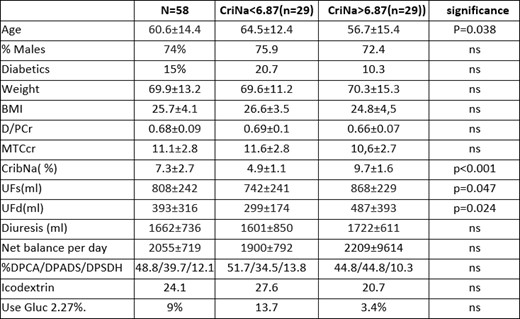-
PDF
- Split View
-
Views
-
Cite
Cite
Byron Andrés Chiliquinga Morales, Astrid Rodriguez Gomez, Maria Elisa Casado Montero, Carmen Martin Varas, Leonardo Calle Garcia, Paulo García Gutiérrez, Pablo Luis Sánchez Garrote, Carlos Santos Alonso, Maria Nieves Losada, Maria Jose Fernandez-Reyes Luis, #2055 Variations in free water transport condition ultrafiltration capacity since basal times, Nephrology Dialysis Transplantation, Volume 39, Issue Supplement_1, May 2024, gfae069–1657–2055, https://doi.org/10.1093/ndt/gfae069.1657
Close - Share Icon Share
Abstract
There is great variability in free water carrying capacity (FFWC) in incident patients, but the extent to which this variability impacts inherent ultrafiltration failure (UF) is unknown. The peritoneal equilibration test (PET) with 3.86% glucose allows measurement of permeability (D/Pcr), standard UF (UFs) and sodium screening (CriNa) as an indirect measure of TAL.
Our objectives were to determine to what extent variations in free water transport condition a related ultrafiltration failure. To assess, according to the variables studied, whether or not the patient`s comorbidities or anthropometric data influenced our study.
We conducted a study in 58 incident patients in our hospital between 2009-2023 in which we evaluated D/Pcr, UFs and CriNa in PET -3.86. We recorded the dialysis pattern and daily UF.
The PET -3.86% results were evaluated (Table 1), showing the clinical and peritoneal transport characteristics of the total patients and the comparison between patients with CriNa lower or higher than the median. The patients with lower CriNa were older and had lower UFs and UFd.
We found a correlation between CriNa and UFs (0.39, p = 0.002) and daily UF (0.318, p = 0.05).
In the multiple regression analysis, CriNa and D/Pcr maintain the correlation with UFs independently. While only CriNa maintains the correlation with daily UF, despite there being no differences in the use of DPA or icodextrin.
On analyzing the results, we found that the intrinsic variations of the membrane, in the free water transport capacity, justify part of the ultrafiltration capacity measured both in kinetics and daily ultrafiltration. As for age, we found that the older the patient is, the lower the sodium sieving, at least initially. With this study we emphasize the importance of assessing variations in free water transport capacity using the peritoneal equilibrium test as a tool.
UFs: standard UF PET -3.86% 4 hours, UFd: daily UF, CribNa: sodium screening, CAPD: continuous ambulatory peritoneal dialysis, DPADS: daytime ambulatory peritoneal dialysis.

UFs: standard UF PET -3.86% 4 hours, UFd: daily UF, CribNa: sodium screening, CAPD: continuous ambulatory peritoneal dialysis, DPADS: daytime ambulatory peritoneal dialysis.






Comments